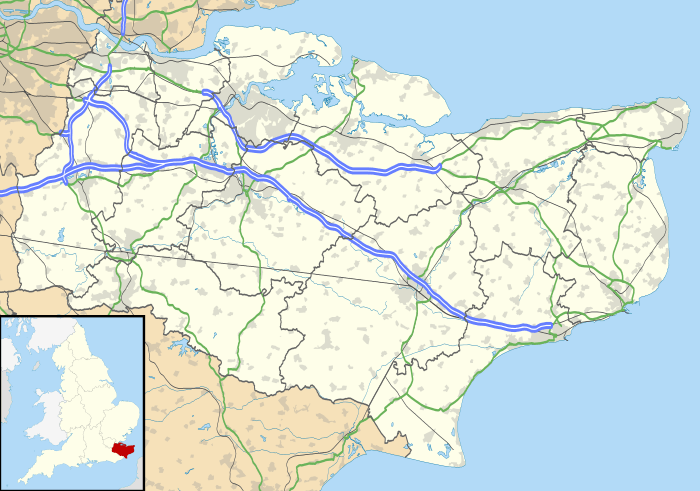Ide Hill
Ide Hill is a village within the civil parish of Sundridge with Ide Hill, in the Sevenoaks District of Kent, England. It stands on one of the highest points of the sandstone ridge about five miles south-west of Sevenoaks. Its name first appears on record in 1250 as Edythehelle. It is an eponymic denoting 'Edith's hill', from the Old English hyll 'hill'.
| Ide Hill | |
|---|---|
 St Mary's Church, Ide Hill, Kent | |
 Ide Hill Location within Kent | |
| OS grid reference | TQ486518 |
| Civil parish | |
| District |
|
| Shire county | |
| Region | |
| Country | England |
| Sovereign state | United Kingdom |
| Post town | SEVENOAKS |
| Postcode district | TN14 |
| Dialling code | 01732 |
| Police | Kent |
| Fire | Kent |
| Ambulance | South East Coast |
| UK Parliament | |
The church is relatively modern. The village had an Anglican chapel in 1806,[1] built by Beilby Porteus, Bishop of London, who lived in nearby Sundridge; St Mary's church was built in 1865 and "has the distinction of being the highest church in Kent" [The Kent Village Book] at 216 metres above sea level, as well as boasting a beautiful lychgate, crafted by local builder Cecil 'Dusty' Boakes. There are several old buildings round the sloping village green, including the 18th-century Cock Inn and the Ide Hill Village School, built in 1856 it is the second home of the school which unusually for a church school predates the church building as the school was formed in 1809.
Ide Hill Football Club, who have teams in the Kent County League, the Sevenoaks & District League and the Crowborough & District Junior League, play their home games on the Ide Hill Recreation Ground (behind the Cock Inn) . As per the church, the football pitch "has the distinction of being the highest in Kent".
Two of Kent's places of interest are near Ide Hill: Bough Beech Reservoir and Emmetts Garden.
Bough Beech Reservoir was completed in 1969. A large area round it is leased to the Kent Trust for Nature Conservation as a nature reserve.
Emmetts Garden is in the care of the National Trust. It was laid out in the late 19th century. There is a stone seat near the village church to commemorate Octavia Hill, one of the Trust's founders.
In his memoir Down and Out in Paris and London George Orwell reports that Ide Hill was notorious for being the worst “spike” (a casual ward or homeless shelter) in all of England. Although in a footnote he confesses to finding it 'not so bad'.[2]
Goathurst Common
Goathurst Common is a hamlet within the civil parish of Sundridge with Ide Hill. It lies to the east of Ide Hill. Its road, Bessels Green Road, leads through Whitley Forest to the village of Bessels Green, near Sevenoaks to the south. There is no current chapel or church. The hamlet did have two but they have been converted into houses. It is a mainly residential area consisting of about sixty houses built since the early 1920s.[3] Goathurst Common is separated from Ide Hill by Stubbs Wood.
Nearest settlements
References
- [21 July 1806 according to Bishop Beilby Porteus Notebooks MS2104, fol. 82]
- p. 202
- "Goathurst Common-Ide Hill". www.bbc.co.uk. 2011. Retrieved 19 November 2013.
External links
| Wikimedia Commons has media related to Ide Hill. |
- Ide Hill Village
- The Parish Churches and Community Information
- Bough Beech Reservoir
- Emmetts Garden
- Ide Hill Society
- Ide Hill Conservation Area Appraisal. Sevenoaks District Council.
